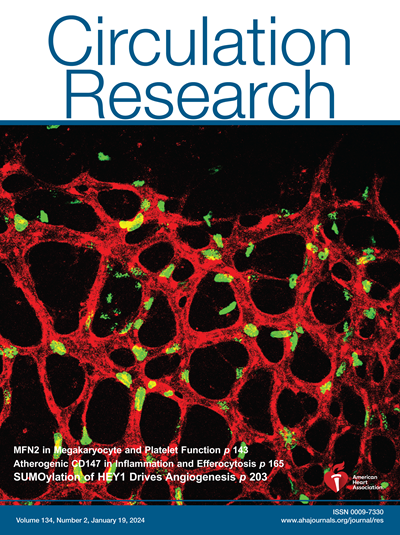失眠表型、心血管风险及其与大脑健康的关系。
IF 16.2
1区 医学
Q1 CARDIAC & CARDIOVASCULAR SYSTEMS
引用次数: 0
摘要
大约30%到40%的普通人群有失眠症状,难以开始或维持睡眠,另有10%到15%的普通人群有慢性失眠障碍。在患有心血管代谢危险因素、心血管疾病、脑血管疾病和神经认知障碍(包括血管性认知障碍)的人群中,失眠的患病率不成比例地高。事实上,最近来自流行病学研究的荟萃分析证据表明,失眠,特别是当伴有客观睡眠时间不足时,是发生高血压、2型糖尿病、心力衰竭、中风、认知障碍、阿尔茨海默病和全因死亡率的危险因素。因此,失眠应该成为预防和管理这些不良健康结果的一部分。然而,随机临床试验并没有证明用认知行为疗法治疗失眠、一线指南推荐的治疗或催眠/镇静剂是否能改善心脏或大脑相关的结果。研究也未能考虑到失眠是一种异质性疾病,由不同的表型组成,这些表型是由生物因素和认知行为因素的相对贡献造成的。目的:短睡眠时间已成为失眠的生理过度觉醒的标志(即,下丘脑-垂体轴调节失调,交感神经系统激活增加,炎症增加),作为失眠相关的不良心脏和大脑健康结果的预测因子,并且可能对失眠的认知行为治疗反应不佳。本文综述了失眠与心脏代谢危险因素、心血管疾病、脑血管疾病和神经认知障碍相关的meta分析证据,包括目前对该疾病异质性的了解。本文还总结了导致心脏和大脑发病的潜在病理生理机制,这些机制因客观睡眠时间的不同而不同。这篇综述表明,基础科学和临床科学需要揭示失眠表型的分子、细胞和行为机制,因为它们与心脏和大脑健康不良相关的公共卫生和临床意义需要立即得到关注。本文章由计算机程序翻译,如有差异,请以英文原文为准。
Insomnia Phenotypes, Cardiovascular Risk and Their Link to Brain Health.
About 30% to 40% of the general population experiences insomnia symptoms of difficulty initiating or maintaining sleep, and another 10% to 15% of the general population experiences chronic insomnia disorder. The prevalence of insomnia is disproportionately higher in people with cardiometabolic risk factors, cardiovascular diseases, cerebrovascular diseases, and neurocognitive disorders, including vascular cognitive impairment. In fact, recent meta-analytic evidence from epidemiological studies has demonstrated that insomnia, especially when accompanied by objective short sleep duration, is a risk factor for incident hypertension, type 2 diabetes, heart failure, stroke, cognitive impairment, Alzheimer disease, and all-cause mortality. Insomnia should, thus, be part of the prevention and management of these adverse health outcomes. However, randomized clinical trials have not demonstrated whether treatment with cognitive-behavioral therapy for insomnia, the first-line guideline-recommended treatment, or hypnotics/sedatives improves heart- or brain-related outcomes. Studies have also failed to consider insomnia a heterogeneous disorder consisting of distinct phenotypes that result from the relative contribution of biological versus cognitive-behavioral perpetuating factors. Objective short sleep duration has emerged as a marker of physiological hyperarousal in insomnia (ie, dysregulation of the hypothalamic-pituitary axis, increased sympathetic nervous system activation, and increased inflammation), as a predictor of insomnia-related adverse heart and brain health outcomes and, potentially, poor response to cognitive-behavioral therapy for insomnia. This review summarizes the meta-analytic evidence on the association of insomnia with cardiometabolic risk factors, cardiovascular diseases, cerebrovascular diseases, and neurocognitive disorders, including current knowledge on the heterogeneity of the disorder. This review also summarizes the potential pathophysiologic mechanisms that lead to heart and brain morbidity, which vary across insomnia phenotypes based on objective sleep duration. This review suggests that basic and clinical sciences need to unveil the molecular, cellular, and behavioral mechanisms at play across insomnia phenotypes, as the public health and clinical implications of their association with adverse heart and brain health are demanding immediate attention.
求助全文
通过发布文献求助,成功后即可免费获取论文全文。
去求助
来源期刊

Circulation research
医学-外周血管病
CiteScore
29.60
自引率
2.00%
发文量
535
审稿时长
3-6 weeks
期刊介绍:
Circulation Research is a peer-reviewed journal that serves as a forum for the highest quality research in basic cardiovascular biology. The journal publishes studies that utilize state-of-the-art approaches to investigate mechanisms of human disease, as well as translational and clinical research that provide fundamental insights into the basis of disease and the mechanism of therapies.
Circulation Research has a broad audience that includes clinical and academic cardiologists, basic cardiovascular scientists, physiologists, cellular and molecular biologists, and cardiovascular pharmacologists. The journal aims to advance the understanding of cardiovascular biology and disease by disseminating cutting-edge research to these diverse communities.
In terms of indexing, Circulation Research is included in several prominent scientific databases, including BIOSIS, CAB Abstracts, Chemical Abstracts, Current Contents, EMBASE, and MEDLINE. This ensures that the journal's articles are easily discoverable and accessible to researchers in the field.
Overall, Circulation Research is a reputable publication that attracts high-quality research and provides a platform for the dissemination of important findings in basic cardiovascular biology and its translational and clinical applications.
 求助内容:
求助内容: 应助结果提醒方式:
应助结果提醒方式:


